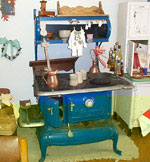|
Coal
Stoves were vital in coal-mining communities.
Only one third of the households in the
United States had electricity in 1930, and
Scott's Run was no exception. Gas, kerosene,
and oil were generally used for lamps, while
coal was used for heat. To fuel these stoves,
many women and children would collect fallen
coal from along the train tracks. They would
start the fire with twigs or scrap wood
and would put the coal under the burners,
which on this particular stove, pulled up.
This stove also has a warming cabinet, an
option that was not standard on all coal
stoves, as well as a side compartment, to
keep the heat in the oven more even. These
stoves also had grates which were used to
clean the ashes out everyday. One common
option that this stove does not have is
a cast iron container for water. This would
be attached to the side of the stove, and
families would fill it in order to have
hot water for doing dishes and bathing.
Around 1930, only one third of the households
in Scott's Run had indoor plumbing. Additionally,
there was only one communal water pump that
could be quite far from the individual houses.
A container on the stove made it much easier
to have warm water in the home.
|
 |